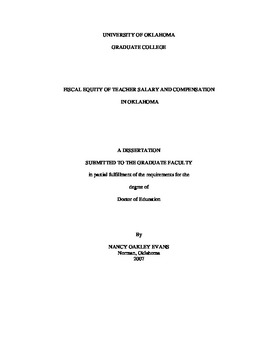| dc.contributor.advisor | Maiden, Jeffrey, | en_US |
| dc.contributor.author | Evans, Nancy Oakley. | en_US |
| dc.date.accessioned | 2013-08-16T12:20:42Z | |
| dc.date.available | 2013-08-16T12:20:42Z | |
| dc.date.issued | 2007 | en_US |
| dc.identifier.uri | https://hdl.handle.net/11244/1212 | |
| dc.description.abstract | This quantitative study investigated the equitable distribution of resources to determine their accessibility to all children attending public schools in Oklahoma. With No Child Left Behind (NCLB) schools are mandated to employ "highly qualified" teachers. Teachers are an important resource and their significance is emphasized more as schools attempt to increase student achievement. Every student educated in Oklahoma should have an equal right to educational resources. Teacher salaries consume the largest portion of the educational budgets and an investigation of salaries and compensation as a resource was warranted. This study investigated two fiscal years; 2000, the year before a $3000 pay raise was awarded, and 2005, the most recent year after the pay raise. Descriptive statistics were used to determine horizontal equity and with correlations, regression analysis, the Gini coefficient, and McLoone index used to determine wealth neutrality. Instructional salaries and total instructional compensation were inequitably distributed in Oklahoma and the degree of inequity increased from fiscal years 2000 to 2005. Wealth neutrality was examined using both the Gini coefficient and McLoone index and it was determined that the distribution of resources was dependent upon where a student resides. Four variables, assessed property valuation, socioeconomic status, percentage of Caucasian students, and proximity to a bordering state were investigated to determine their impact on the distribution of resources. All variables, except the percentage of Caucasian students, were found to significantly influence the distribution of resources. This study exposed some inequities that exist in the distribution of instructional salaries and total instructional compensation in Oklahoma thus preventing all students who are educated in our public schools from receiving equal access to resources that determine the quality of educational instruction the student receives. | en_US |
| dc.format.extent | x, 135 leaves : | en_US |
| dc.subject | Equal pay for equal work Oklahoma. | en_US |
| dc.subject | Education, Finance. | en_US |
| dc.subject | Education Oklahoma Finance. | en_US |
| dc.subject | Teachers Salaries, etc. Oklahoma. | en_US |
| dc.title | Fiscal equity of teacher salary and compensation in Oklahoma . | en_US |
| dc.type | Thesis | en_US |
| dc.thesis.degree | Ed.D. | en_US |
| dc.thesis.degreeDiscipline | Department of Educational Leadership and Policy Studies | en_US |
| dc.note | Adviser: Jeffrey Maiden. | en_US |
| dc.note | Source: Dissertation Abstracts International, Volume: 68-04, Section: A, page: 1336. | en_US |
| ou.identifier | (UMI)AAI3263439 | en_US |
| ou.group | Jeannine Rainbolt College of Education::Department of Educational Leadership and Policy Studies | |
